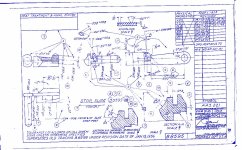Aguila Blanca
Staff
I hope someone out there has better Google-fu than I do. I have encountered a bit of a puzzler:
Cleaning up my (physical) desktop, I unearthed a scrap of paper on which I scribbled some dimensions for the distance the slide stop lug on 1911s projects beyond the out face of the frame (i.e. how far the lug projects into the magazine well). The dimensions I have are:
Unmarked: .197 Standard .45
Number 1: .197 Caliber .45
Number 2: .205-.210 ACE, Conversion Unit, .38 AMU and .38 NM
Number 3: .215-.220 Super .38 & .38 Super Auto [I think this means .38 ACP and .38 Super]
Number 4: . . . . . . . . [nothing typed -- hand scribbled .40 S&W / 10mm ??]
M: . . . . . . .197 Match
So this leads to a couple of questions: First, the copy of the Ordnance Deprt drawings for the M1911 call for this dimension to be 0.201"-.009". .197 is within that range, but is the correct dimension .197" or is it .201 - .009?
Second question: I know Brownells sells slide stops earmarked as being for 9mm. Are those the same as the Number 2 for .38 ACP and .38 Super?
Third question: Is the Number 4 used for .40 S&W and 10mm? If not, what is the Number 4 used for?
Last question: What is the dimension for the Number 4?
Thanks.
Cleaning up my (physical) desktop, I unearthed a scrap of paper on which I scribbled some dimensions for the distance the slide stop lug on 1911s projects beyond the out face of the frame (i.e. how far the lug projects into the magazine well). The dimensions I have are:
Unmarked: .197 Standard .45
Number 1: .197 Caliber .45
Number 2: .205-.210 ACE, Conversion Unit, .38 AMU and .38 NM
Number 3: .215-.220 Super .38 & .38 Super Auto [I think this means .38 ACP and .38 Super]
Number 4: . . . . . . . . [nothing typed -- hand scribbled .40 S&W / 10mm ??]
M: . . . . . . .197 Match
So this leads to a couple of questions: First, the copy of the Ordnance Deprt drawings for the M1911 call for this dimension to be 0.201"-.009". .197 is within that range, but is the correct dimension .197" or is it .201 - .009?
Second question: I know Brownells sells slide stops earmarked as being for 9mm. Are those the same as the Number 2 for .38 ACP and .38 Super?
Third question: Is the Number 4 used for .40 S&W and 10mm? If not, what is the Number 4 used for?
Last question: What is the dimension for the Number 4?
Thanks.

